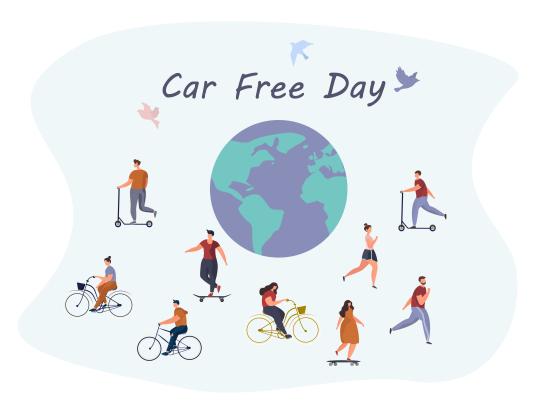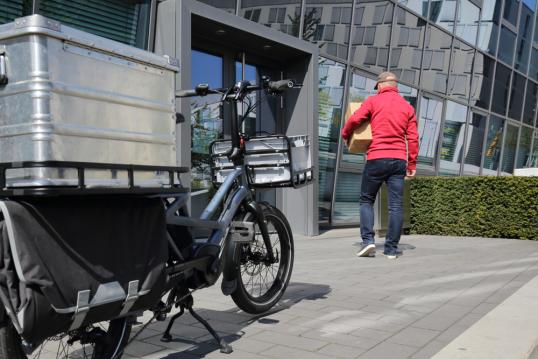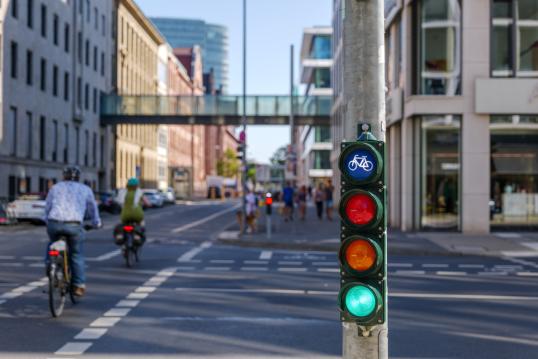- Topic
- Urban mobility planning
- Country
- Europe-wide
- Resource type
- Case study
First published on 20 June 2023.
Urban mobility measures have great energy-saving potential and can be implemented at a range of governance levels from local to national, accompanied by various challenges and opportunities. These measures are crucial to achieving Europe’s sustainability goals, and at the same time help to alleviate dependence on Russian fossil fuels. Strategies that encourage public transport use, innovative micromobility schemes, zero-emission logistics and Car-Free Days, akin to those organised during European Mobility Week, are some of the options that can be implemented to improve energy efficiency, lead to energy savings, and prevent further increases in the volume of congestion. Co-benefits are created by the successful implementation of such measures, as can be seen in the range of cities already taking action.
Context
Energy saving and efficiency are key components of strategies, not only to reduce the environmental impact of mobility and transport systems, including their impact on the climate, but also to achieve independence from Russian fossil fuels well before 2030. These challenges are significant in scale but can be tackled through a broad range of actions across cities and Member States, both in the EU and further afield.
The European Commission adopted the REPowerEU Plan on 18 May 2022 to quickly reduce the EU’s dependence on Russian fossil fuels. The increased use of walking, cycling and public transport, as well as more car-free days, are highlighted as being part of the solution, as these have the potential to make savings of 5 Mtoe (million tonnes of oil equivalent).
As 85% of Europeans believe that the EU should reduce its dependency on Russian gas and oil as soon as possible, by acting as a Union, Europe hopes to achieve this faster.
Urban mobility energy-saving measures generally fall into one of three categories:
- Preventing further increases in traffic volume and reducing existing demand where possible.
- Shifting demand to more efficient modes of transport and improving public transport service networks.
- Improving the efficiency of vehicles and improving the environmental performance of fuels.
When these different kinds of measures are implemented in harmony, the result can be a far more energy-efficient mobility system, with co-benefits for residents, policymakers and transport users.
In action
Possible urban mobility energy-saving measures that can be adopted by all include:
- Car-free days: Cities can organise regular car-free days to encourage active mobility. ‘Energy Saving’ is the 2023 theme of the European Mobility Week annual campaign, for which six quick guide factsheets are available online, together with a flyer on how to organise a car-free day in 10 steps.
- Car-free zones to encourage active mobility: Cities can set up car-free zones, which can reduce car use and also lead to improvements in public health.
- Lower prices for buses and rail: Lower prices can be used to make public transport more attractive for users, thus increasing the incentive for car users to switch transport modes.
- Reduced speed zones: Reduced speed zones can help to reduce CO2 emissions and fuel consumption by up to 25%, in addition to increasing road safety.
- Road-charging schemes to reduce rush hour congestion: Cities can implement road charging schemes, or adapt existing ones, to reduce car use at peak travelling times.
- Incentivise the use of zero-emission vehicles: Cities can incentivise the use of zero-emission vehicles.
- Bike-sharing and micromobility schemes: Cities can support sharing schemes for micromobility options, to provide alternatives to car use.
- Bicycle purchase subsidies or tax reductions: Subsidies and tax reductions can be implemented to encourage the uptake of cycling as an alternative to car use.
- Incentives for employees commuting with public transport or active transport modes: Rewarding employees who cycle, walk or use public transport to commute is a strong incentive to use these modes for commuting instead of the car.
- Investment in new cycle lanes: Cities can invest in new infrastructure for cyclists, thus making it easier and safer to cycle as an alternative to using a car.
- Last-mile delivery by cargo bikes or smaller e-vehicles: Cities can promote and facilitate last-mile deliveries by cargo bikes and small electric vehicles, in order to replace larger, more polluting vehicles.
- Increase options for taking bicycles on trains and the metro: Cities can invest in new infrastructure to make it easier to take bicycles on the metro and train networks, thus making it easier to travel longer distances using modes other than the car.
Results
Implementing urban mobility measures that save energy has been used to trigger a range of positive results in cities. Examples of measures that have delivered convincing results are presented below.
‘Good Move’, the mobility plan of the Belgian capital, Brussels, introduced a city-wide 30km/h speed limit to reduce air and noise pollution, which has also resulted in fewer traffic accidents. This involved banning through-traffic in specific areas, thus creating space for walking, cycling and public transport, while also improving the attractiveness of public spaces for people to meet up and enjoy the city. As through-traffic accounted for 30% of traffic in Brussels yet, in many cases, resulted in a time saving of only a few minutes, this strategy stands to bring important benefits to local residents.
Motorists who shift from car ownership to car sharing typically reduce their car use by 30-60%. Moving from ownership to sharing allows households to rely more on alternative transport modes, with scooter and bike-sharing often providing helpful substitutes for automobile trips.
The Ecozone project in Mechelen, Belgium, used measures that optimise distribution systems to drastically cut polluting last-mile postal deliveries, which have led to curbing CO2 emissions by 97% and fine particles by 77% since the project launched in July 2020. The project allows only zero emission vehicles to be used for dropping-off and picking-up post in town and created a network of pick-up points open 24/7 that recipients can reach easily, thereby reducing the number of failed deliveries, which account for 8% of traffic in Mechelen. In addition, the project encouraged local residents to collect their parcels in person on foot or by bike.
The creation of a pop-up bike lane on the major street, Kantstraße, in the German capital, Berlin, saw motorised traffic on this street drop by 22% on average between April 2020 and October 2021, while the number of cyclists increased by 232%, in comparison with a 22.6% increase in cyclists across the entire city over the same period. This followed a serious accident in February 2020 where a 64-year old cyclist was fatally injured. In summer 2020 this became the longest pop-up cycle path in Germany. The impact of the new cycle path on air pollution has shown significant improvements in air quality, which in turn has assuaged the fears that the pop-up cycle lane could lead to increased congestion.
Since the start of the Breikers network in the Dutch capital, Amsterdam, in 2015, more than 250 employers have joined and received advice and support on influencing the mobility habits of their employees. This has resulted in a reduction of more than 12,000 journeys during peak hours and over 180,000 kilometres of passenger car use. As vehicle users spend approximately 60 hours per year in traffic jams, the potential benefits from the better management of workplace-related mobility are substantial. Measures that were incorporated include a range of Mobility-as-a-Service (MaaS) solutions, a rideshare app, company car schemes, bike and e-bike leasing, updated parking policies and flexible working opportunities. While the extent of the changes in mobility at a particular company vary depending on their objectives, receiving advice tailored to their business needs helps to overcome the particular obstacles that they may encounter.
Car-free days are a tool already being successfully implemented across many European cities, such as Braga in Portugal, Bulgaria’s capital Sofia and the Croatian capital Zagreb, although there is still room for more widespread implementation. As part of the events in these cities, not only are cycling and walking through a city’s main arteries encouraged and enabled, but activities are also organised in partnership with companies located in central areas. Open air dance performances, mass bike rides and cycling breakfasts were implemented in Zagreb throughout its most recent Car Free Day celebration. Sofia held a “Food and Spices Walking Tour” and an electric bicycle information event, among others. Braga took the opportunity to implement a “Mobility Safari” with 30 companies to underline the importance of decarbonisation and sustainable mobility to health. Both Sofia and Zagreb were selected as finalists in the 2022 European Mobility Week awards for the success of their Car-Free-Day activities, while Braga was the overall winner.
Other city level implementation examples include:
- The Czech capital, Prague's electric cargo bike depot is one of Europe’s best zero-emission projects.
- The Spanish city of La Línea has plans to decarbonise the city centre.
- Bucharest, the Romanian capital, has created the ‘Open Streets’ network of pedestrian zones for the weekend.
Challenges, opportunities and transferability
Challenges faced when trying to encourage cycling in cities include the perception that cycling is not safe when cyclists share road space alongside motorised transport. To tackle such problems, cycling should be “a shared vision, not only horizontally across the various policy departments, but also vertically, across various levels of governance.” The SUMP Practitioner Briefing on Supporting and encouraging cycling in sustainable urban mobility planning provides guidance to help overcome this.
The Principles of the International Charter for Walking (as detailed in the SUMP Practitioner Briefing on Supporting and encouraging walking in sustainable urban mobility planning) highlight a range of important benefits and considerations relating to encouraging walking, some of which have crossovers with cycling. These include:
- increased inclusive mobility;
- well designed and managed spaces and places for people;
- improved integration of networks;
- supportive land-use and spatial planning;
- reduced road danger;
- less crime and fear of crime;
- more supportive authorities;
- a culture of walking.
In the context of energy-saving urban mobility measures, making public transport more attractive should be regarded as a critical challenge. It is worth noting that governance challenges can be very different from one country to another and this is an aspect which intersects with many of the difficulties that arise when working to make public transport more attractive. More information can be found in the SUMP Topic Guide on Planning for attractive public transport.
Mobility management - promoting sustainable transport and managing the demand for car use by changing travellers’ attitudes and behaviour, in particular at the level of companies, organisations and institutions - should be considered as a dynamic process where a package of measures and campaigns are identified, piloted and monitored on an on-going basis. More information can be found in the SUMP Topic Guide on Integrating Mobility Management for Public and Private Organisations into SUMPs. The European Commission further supports mobility management through its targeted MOBILITYACTION award.
When aiming to incentivise the use of zero-emission vehicles it is important to understand that integrating electric mobility into sustainable urban mobility planning strategies does not simply equate to replacing diesel and petrol vehicles with their electric counterparts. Rather, a number of specific issues must be anticipated and addressed, including the provision of vehicle charging infrastructure, the need for cooperation with a wide range of stakeholders, and adapting parking regulations for electric vehicle users. More information can be found in the SUMP Topic Guide on Planning for electric road transport in the SUMP context.
The introduction and integration of bike-sharing and micromobility services raise their own challenges, of which cities are becoming increasingly aware. Seeing micromobility as an opportunity for deploying a new governance framework to pilot integrative transport services helps to turn the obstacles faced into lessons learnt (more information can be found in the SUMP Topic Guide on Safe use of micromobility devices in urban areas).
Regulatory models and integration processes pose choices that must be made based on an adequate understanding of the needs of end users. However, when considering how to address the introduction of micromobility modes, predicting behaviour can prove challenging. This issue of uncertainty ties into the “decide and provide” approach being recommended as a strategy to cope with the uncertain travel behaviour in the wake of the Covid-19 pandemic (more information can be found in ITF’s Shaping Post-Covid Mobility in Cities report).
To minimise the possible negative consequences triggered by implementing shared mobility approaches, it is important to ensure ride-sharing services, for example, do not compete with public transport. In parallel, to exploit the full benefits of shared mobility, local authorities must recognise the scope of their options in new circumstances. More information can be found in the SUMP Topic Guide on the Integration of shared mobility approaches in sustainable urban mobility planning.
The principles that can be used to address a number of the challenges outlined above overlap with best practice in sustainable urban mobility planning. By involving relevant stakeholders, developing transport modes from a holistic point of view, and cooperating across various institutional boundaries, successful policymaking can be accelerated and effective energy-saving urban mobility measures can be put into action.
In Depth
How to organise a Car-Free Day in 10 steps
Do emissions and fuel used increase with 20mph limits?
Brussels starts to remove through traffic from its city centre
Win-Win Transportation Emission Reduction Strategies
Put on your slippers: zero-emission deliveries are here – Ecozone project in Mechelen
Traffic impact of pop-up cycle path Kantstraße (in German)
'Work Smart, Travel Smart' – Mobility management in Amsterdam – Breikers network
European Mobility Week – Braga, Portugal
European Mobility Week – Sofia, Bulgaria
European Mobility Week – Zagreb, Croatia
Prague's electric cargo bike depot is one of Europe’s best zero-emission projects
The Spanish city of La Línea has plans to decarbonise the city centre
Bucharest creates a network of pedestrian zones for the weekend
Shaping Post-Covid Mobility in Cities
SUMP Topic Guide on Planning for attractive public transport
SUMP Topic Guide on Planning for electric road transport in the SUMP context
SUMP Topic Guide on Safe use of micromobility devices in urban areas
SUMP Topic Guide on Integrating Mobility Management for Public and Private Organisations into SUMPs
Author: Francine Long
Views and opinions expressed are those of the author(s) and do not reflect those of the European Commission.
Photo Credits: © Lorenzo Photo Projects, Thomas Quack, Irya Tymoshenko, Montri Thipsorn, Quality Stock Arts, Peeradontax/ Shutterstock.com - no permission to re-use image(s) without separate licence from Shutterstock.






